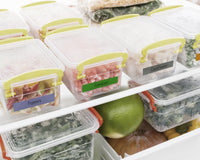
Inventory consists of keeping track of the product you have and what you need to order. It is critical to successfully running a restaurant. To ensure you always have enough product on hand, follow these easy inventory control techniques for restaurants.
1. Label Food and Boxes
A necessary part of the inventory and managing federal food regulations is to label everything. These labels should include the type of food, delivery date, and use by date. When you receive inventory, it can be difficult to differentiate what’s new or old when you have a lot of boxes and limited space. We recommend you use assorted color-coding labels. You can separate what’s old and new based on color as well as the information on the label. This is the easiest way to stay organized in an industry where efficiency is crucial.
2. Keep Shelves Organized
In addition to color-coding boxes with labels, you should try your best to organize shelving. A great way of doing this is to implement the first in first out method. This means you will put food that has the nearest upcoming use by date toward the front of the supply. You should also consider labeling the shelves themselves. You can base these labels on what’s old and new, the products stored there, or any other component that relates to how you keep inventory.
3. Record It by Hand
To maintain proper inventory techniques, you must have someone who consistently checks on it. The person who checks inventory must be familiar with the process—they’ll be in charge of tracking various elements. For example, they’ll stay on top of order planning and tracking, spoilage and spillage occurrences, as well as instances of improper preparation and complaints. The individual looking over inventory will ensure you never run low or are out of a product.
4. Refer to Previous Orders
An easy way to maintain inventory is to refer to previous orders. This will give you an idea of what you must keep in stock at all times. Referring to past orders will also allow you to spot any inconsistencies and patterns that are unique to your specific set up. You don’t want to use it verbatim, however—just using it as a guide can be extremely helpful.
5. Take Note of Waste
Your sales are not going to fully reflect your supply quantities. As such, you’ll need to take note of what you have to throw away. Restaurateurs know that, unfortunately, you are losing money any time you throw out food. However, you can make up for this loss on your next order. Tracking food waste can help you make smarter choices during future orders, ultimately saving you time and money.
Update from April 2021
Color coded dots can be a helping hand in multiple ways. Large dots can be used to label boxes. Smaller dots can be used to mark inventory sheets. Labeling tape can also com in handy as you can use as much or as little as you need, and you can write on the tape with marker.









